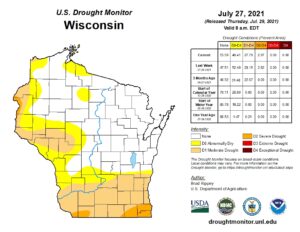The accumulated lack of precipitation we experienced the first part of this year has produced severe drought conditions in southern Lafayette, southern Walworth, Racine and Kenosha counties as of the end of last week.
Moderate drought continues across southern Sauk, southern Columbia, Dodge, Washington, Ozaukee, Iowa, Dane, Jefferson, Waukesha, Milwaukee, Green and Rock counties as well.
Since Aug. 1, 2020, Madison has recorded a deficit of 10.34 inches of precipitation. That translates to only 71.6% of the area’s normal amount of precipitation over that interval.
Most alarming is that the growing season months of April, May and now July have contributed 7.04 inches of that 10.34-inch deficit. As a result, 33% of the region’s top soil and 35% of its subsoil moisture is currently considered “short” or “very short” by the National Weather Service’s U.S. Drought Monitor.
Some crops are beginning to show signs of stress under these conditions.
To make matters worse, there appears to be no relief on the immediate horizon. Any precipitation in the next seven or so days — if it occurs at all — will likely be the result of local thundershowers and will not be associated with the passage of a well-organized, “synoptic-scale” weather system (covering hundreds or thousands of miles) capable of delivering widespread precipitation.
In addition, the monthly climatological drop-off in precipitation from August (4.27 inches is normal) to September (3.13 inches is normal) is the largest such drop-off in the calendar year.
Consequently, a wet August is perhaps our last best hope for returning closer to normal and forestalling a compromised growing season.
Steve Ackerman and Jonathan Martin, professors in the UW-Madison department of atmospheric and oceanic sciences, are guests on WHA radio (970 AM) at 11:45 a.m. the last Monday of each month. Send them your questions at stevea@ssec.wisc.edu or jemarti1@wisc.edu.


